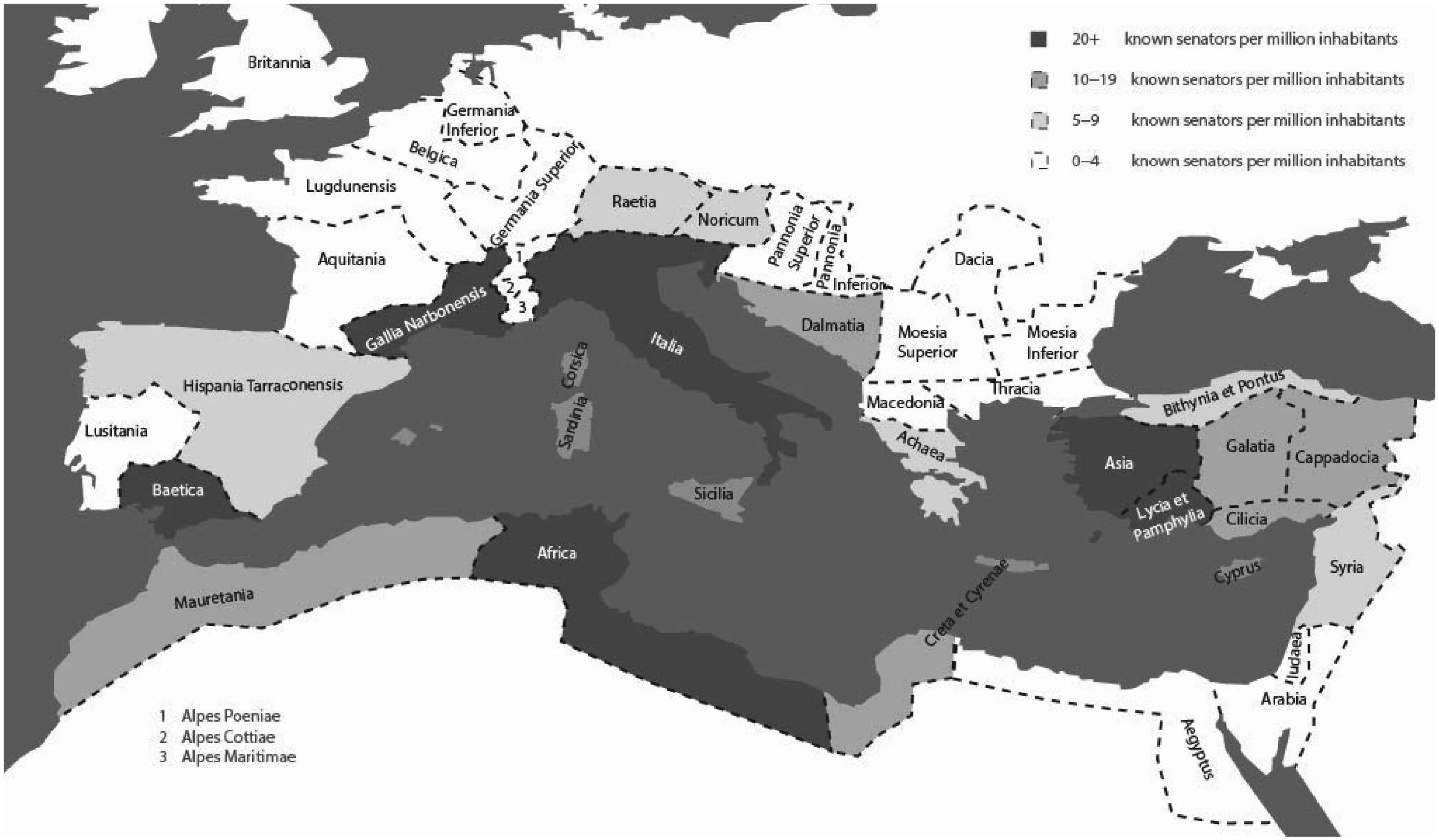Map of Provincial Origins of Senators During Pax Romana


David Chen
Data Visualization Specialist
David Chen is an expert in transforming complex geographic datasets into compelling visual narratives. He combines his background in computer science ...
Geographic Analysis
What This Map Shows
This map illustrates the diverse provincial origins of senators during the Pax Romana, a period of relative peace and stability across the Roman Empire that spanned from 27 BCE to 180 CE. By examining the geographical distribution of senators, we gain insights into the broader social and political landscape of this era. The map highlights various provinces, showcasing where senators hailed from, which in turn reflects the diversity of the Roman political class and the extent of Roman influence across different regions.
Deep Dive into the Provincial Origins of Senators
During the Pax Romana, the Roman Senate was not just a collection of aristocrats from Rome; it included individuals from numerous provinces, emphasizing the empire's vastness and diversity. Ever wondered why senators came from such a wide array of regions? The answer lies in the structure of Roman governance and the increasing integration of conquered territories into the imperial framework.
The provinces, such as Gaul, Hispania, Africa, and parts of Asia Minor, contributed to a senatorial class that was more representative of the empire's demographics than one might initially assume. For instance, the presence of senators from Gaul indicates that this region was not merely a conquered land but had become an integral part of Roman political life.
Interestingly, many of these senators were born into local elite families who had adopted Roman customs, language, and governance styles. This assimilation process was crucial for Rome's expansion strategy, as it helped to stabilize newly acquired territories by integrating local leaders into the Roman political system. Statistically, by the end of the 1st century CE, it's estimated that nearly 30% of senators came from provinces outside of Italy, a significant shift from earlier periods when the Senate was predominantly composed of Italians.
Moreover, the political landscape during the Pax Romana was influenced by the emperor's policies. Emperors like Augustus and Trajan favored promoting provincial elites to senatorial status, which not only increased loyalty among the provinces but also helped to quell potential dissent. The increasing number of provincial senators can be seen as a reflection of Rome’s evolving identity, where local cultures began to intertwine with Roman ideals.
Regional Analysis
Let's break down the map region by region. Starting with Hispania, several senators emerged from this province, reflecting its strategic importance and economic contributions to the empire. Hispania was rich in resources, and its senators played a critical role in overseeing the production and trade of goods such as olive oil and wine.
Moving to Gaul, the representation in the Senate suggests that the region was not only vital for military campaigns but also for administrative governance. The Gauls had a reputation for being fierce warriors, yet they also adapted to Roman customs, leading to a unique blend of cultures in the political arena.
In Africa, the provinces like Carthage became significant centers of trade and commerce, contributing senators who were instrumental in managing grain supplies to Rome. This was vital for maintaining the empire's food security.
Interestingly, regions like Asia Minor showed a mix of both military generals and local elites in the Senate. This dual representation indicates the complexities of Roman provincial governance, where military prowess and local knowledge were both valued.
Significance and Impact
Understanding the provincial origins of senators during the Pax Romana is crucial for several reasons. It reveals how the Roman Empire managed to maintain control over vast territories while fostering a sense of inclusion among conquered peoples. The integration of provincial senators into the Senate not only legitimized Roman authority but also facilitated cultural exchanges that enriched both local and Roman traditions.
Moreover, this phenomenon has modern implications, as it shows the importance of representation in governance. In our contemporary world, the inclusion of diverse voices in political systems remains a hot topic. As we reflect on the lessons from the past, it's clear that the Roman approach to governance can provide insights into current discussions about representation and identity in multi-ethnic societies.
As we look into the future, the ongoing study of such maps can help us understand the dynamics of power, representation, and cultural integration in both historical and modern contexts. We might ask ourselves how the legacy of Roman provincial representation continues to shape political landscapes today. The interplay of local and imperial identities remains relevant, reminding us of the lessons history has to offer.
Visualization Details
- Published
- September 12, 2025
- Views
- 76
Comments
Loading comments...